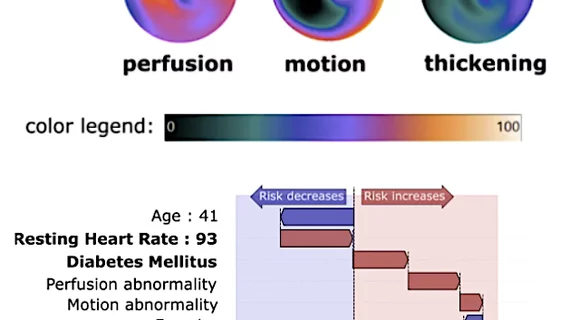New Cedars-Sinai AI tool may predict cardiac events and better assess risk
Cedars-Sinai researchers are developing a deep-learning artificial intelligence (AI) algorithm that offers patients personalized predictions of their heart health. The system also offers a patient-friendly, graphical report that helps explain things more clearly than a text report. The findings were recently published in the peer-reviewed journal NPJ Digital Medicine.[1]
“Using a specific type of AI trained to interpret images of the heart and developed at Cedars-Sinai, we could both predict the chance of cardiac events—like death, heart attack, or the need for urgent treatment of the heart vessels—and show how the likelihood of these adverse events changes over time,” explained Piotr Slomka, PhD, in a statement. He is director of Innovation in Imaging at Cedars-Sinai and a research scientist in the Division of Artificial Intelligence in Medicine and the Smidt Heart Institute.
The AI tool was trained to collect and interrogate basic clinical data like the patient’s age, gender, weight, heart rate and blood pressure. It also incorporates the AI interpretation of images of the heart that show blood flow in the heart muscle and how the heart expands and contracts.
“This general patient data, together with heart imaging, is what the deep-learning platform uses to make cardiac health predictions,” said Slomka, senior author of the study.
The predictions are produced in a graphic format that indicates individual risk for death or heart attack over several years. It also can predict if an invasive cardiovascular intervention is needed, such as stent or bypass surgery. Slomka says the graphs are simple to understand and can be reviewed by both medical professionals and patients.
“Doctors and patients can use these graphs to track how risk changes over time and to identify individual risk factors,” said Slomka. “They can also interactively modify certain risk factors to see how it impacts a patient’s particular risk.”
Conceptually, this novel research could have broad implications, Sumeet Chugh, MD, director of the Division of Artificial Intelligence in Medicine and the Pauline and Harold Price Chair in Cardiac Electrophysiology Research, said in the statement.
“AI algorithms of this nature could enable physicians to communicate more personalized information regarding potential timing of imminent heart disease events, allowing patients to engage more meaningfully in the shared decision-making process,” said Chugh, who also serves as director of the Center for Cardiac Arrest Prevention in the Smidt Heart Institute. “Even more importantly, this tool has the potential to lend data-led, appropriate urgency to heart disease prevention efforts by both patients and providers.”
Slomka and his team of investigators plan to test these tools in clinical trials at Cedars-Sinai in the near future.
“Our ultimate goal is to offer such interactive tools online if images and clinical data are uploaded,” said Slomka.
Slomka's lab has been working on several AI projects in cardiology. The biggest research area has been the development of new AI algorithms to fully automate the analysis of nuclear cardiology data, and integrated motion-corrected analysis of positron emission tomography (PET)/computed tomography (CT) angiography imaging.


